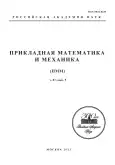On the Kinematic Description of the Motion of a Rigid Body
- Authors: Petrov A.G.1
-
Affiliations:
- Ishlinsky Institute for Problems in Mechanics of the RAS
- Issue: Vol 87, No 5 (2023)
- Pages: 711-719
- Section: Articles
- URL: https://journals.rcsi.science/0032-8235/article/view/232500
- DOI: https://doi.org/10.31857/S0032823523050120
- EDN: https://elibrary.ru/QPJYLE
- ID: 232500
Cite item
Full Text
Abstract
A system of ordinary differential equations is derived for a vector of finite rotation corresponding to Euler’s theorem: the vector of finite rotation is directed along the axis of finite rotation of a solid and its length is equal to the angle of plane rotation around this axis. The system of equations is explicitly resolved with respect to the time derivative of the components of the rotation vector. The right part of the system depends on the rotation vector and the angular velocity vector in the main axes. The equivalence of the obtained system of equations to the system of equations for quaternions is shown. The coordinates of the orts of the main axes of a rigid body in fixed axes are expressed in terms of the angles of final rotation and the components of angular velocity according to simple analytical formulas.
About the authors
A. G. Petrov
Ishlinsky Institute for Problems in Mechanics of the RAS
Author for correspondence.
Email: petrovipmech@gmail.com
Russia, Moscow
References
- Журавлев В.Ф. Основы теоретической механики. М.: Наука, 1997. 320 с.
- Бранец В.Н., Шмыглевский И.П. Применение кватернионов в задачах ориентации твердого тела. М.: Наука. 1973. 320 с.
- Голубев Ю.Ф. Основы теоретической механики. Учебник. 2-е изд., перераб. и дополн. М.: Изд-во МГУ, 2000. 719 с.
- Челноков Ю.Н. Кватернионные и бикватернионные модели и методы механики твердого тела и их приложения. М.: Физматлит, 2006. 512 с.
- Jian S. Dai Euler–Rodrigues formula variations, quaternion conjugation and intrinsic connections // Mech.&Machine Theory, 2015. V. 92. P. 144–152.
Supplementary files









